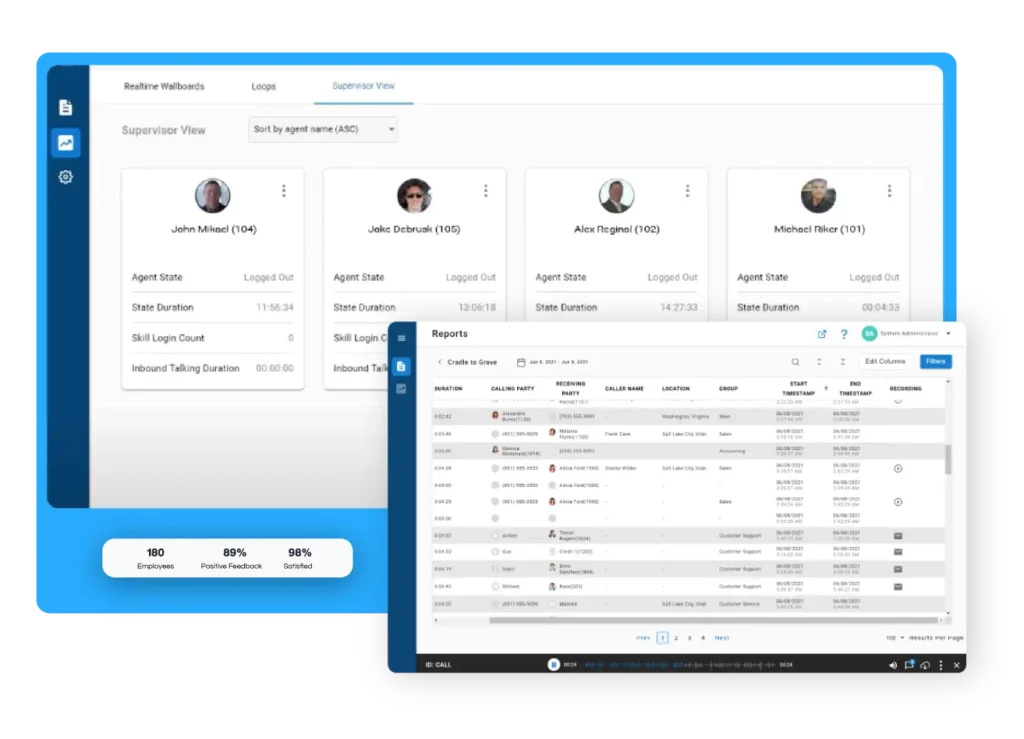Top 10 Call Center Quality Assurance Best Practices
Learn the essential call center quality assurance best practices for consistent excellence, effective coaching, and measurable results.

In today’s digital age, customers expect consistent and convenient ways to connect with businesses of all sizes. Whether it’s through phone calls, emails, live chat, social media, or text messages, they want the ability to interact on their preferred channel and to be able to switch channels seamlessly without customer service representatives losing context of their needs. This is where an omnichannel contact center comes into play.
An omnichannel contact center is a customer service solution that integrates multiple communication channels into a unified platform. Unlike a multichannel approach, where different communication channels exist independently, an omnichannel strategy ensures that all channels work together, providing a seamless customer experience. This means that whether a customer starts an inquiry via email and later follows up through live chat, the conversation history and context remain intact, eliminating the frustration of repeating information.
Both omnichannel and multichannel contact centers allow businesses to communicate with customers across multiple platforms, but the way they handle these interactions makes all the difference in the customer experience.
A multichannel contact center offers multiple communication channels (e.g., phone, email, chat, social media, SMS), but these channels operate independently of each other. This means:
While multichannel contact centers provide customers with options for communication, they do not create a seamless experience between those channels.
An omnichannel contact center integrates all communication channels into a unified system, allowing for a seamless customer journey. This means:
For example, in an omnichannel contact center, a customer could start a conversation via live chat, continue it over email, and finalize it on a phone call—without losing context or having to repeat their issue.
Selecting the right omnichannel contact center solution is critical for delivering seamless customer experiences and maximizing efficiency. Here are the essential features to look for:
Ensure the platform connects all communication channels (voice, email, chat, social media, SMS) into a single interface so agents can track interactions without losing context.
A 360-degree customer profile consolidates interaction history across all channels, enabling personalized and efficient service without requiring customers to repeat themselves.
The system should automatically route inquiries to the most qualified agents based on availability, skill set, or customer priority, optimizing response times and service quality.
AI-driven virtual assistants can handle routine inquiries, deflecting common questions and freeing up live agents for more complex issues. Automated workflows can further streamline operations.
Look for a solution that seamlessly integrates with CRM software (Salesforce, HubSpot, etc.), helpdesk platforms, and other business tools to centralize customer data.
Robust reporting tools help measure agent performance, customer satisfaction, and service trends so businesses can make data-driven decisions to improve operations.
Your solution should be scalable to grow with your business, offering cloud-based deployment options like a Cloud Contact Center, which allows for remote teams and hybrid work environments while maintaining seamless communication across all channels.
Ensure the platform meets industry security standards (e.g., GDPR, HIPAA, PCI-DSS) to protect customer data and maintain compliance with regulations.
Features like agent scheduling, performance tracking, and coaching tools help optimize staffing and improve team productivity.
A simple, intuitive dashboard enhances agent efficiency and reduces training time, allowing teams to adapt quickly to new workflows.
AI plays a crucial role in omnichannel contact centers by enhancing efficiency, personalization, and automation. First, AI-powered chatbots and virtual assistants handle routine inquiries across multiple channels, providing instant responses and reducing agent workload while ensuring seamless transitions for complex issues. Second, intelligent routing and sentiment analysis help direct customers to the right agent based on their needs, urgency, and emotions, improving resolution times and customer satisfaction. Lastly, predictive analytics and automated workflows enable businesses to anticipate customer needs, streamline operations, and provide proactive support, ultimately enhancing the overall customer experience.
Businesses that implement an omnichannel contact center gain several competitive advantages, including:
Customers expect fast, personalized, and efficient service. Omnichannel contact centers enable agents to access full conversation histories, allowing them to provide better, more informed assistance across channels. Cradle-to-grave reporting also allows a view into past interactions for a more complete understanding of the customer.
By consolidating all communication channels into a single interface, agents can efficiently manage interactions without switching between multiple systems, reducing response times and increasing efficiency.
A smooth and consistent customer experience fosters trust and satisfaction, which translates into long-term customer loyalty and repeat business.
Omnichannel platforms provide valuable insights into customer behavior, preferences, and service trends, allowing businesses to refine their customer support strategies.
With streamlined workflows and automated processes, omnichannel solutions reduce operational costs while improving service quality.
For small and midsize businesses (SMBs), adopting an omnichannel contact center may seem like a significant investment, but the benefits far outweigh the costs. Here are five ways SMBs leverage omnichannel communication to provide outstanding customer experiences:
SMBs can engage with customers through their preferred communication channels, whether it’s social media, SMS, email, or phone, increasing customer satisfaction and engagement.
AI-driven chatbots and automated workflows handle common inquiries, freeing up agents to focus on more complex customer needs, improving efficiency and scalability.
With an integrated view of customer interactions, SMBs can provide tailored responses and recommendations, creating a more personalized customer journey.
Omnichannel solutions enable SMBs to handle a high volume of interactions with fewer resources, making customer support more cost-effective.
SMBs can use analytics to track customer interactions, measure service effectiveness, and make data-driven decisions to improve customer experience and business performance.
An omnichannel contact center is no longer a luxury—it’s a necessity for businesses that want to deliver exceptional customer experiences. By unifying all communication channels, businesses of all sizes, including SMBs, can enhance customer satisfaction, increase operational efficiency, and drive long-term success. Investing in the right omnichannel contact center solution allows businesses to meet evolving customer expectations and stay ahead in today’s competitive marketplace.
At Xima Software, we empower SMBs with enterprise-grade omnichannel capabilities without the complexity or high costs. Contact us today to learn how our solutions can transform your customer service operations with exceptional reporting and analytics, powerful configurability, and customer-centric service.
An omnichannel cloud contact center is a cloud-based solution that integrates multiple communication channels—such as voice, email, chat, SMS, and social media—into a unified platform, allowing for seamless customer interactions and enhanced agent efficiency.
An example of omnichannel customer service is when a customer starts a support inquiry via live chat, continues the conversation through email, and later follows up by phone—without having to repeat their issue, as all interactions are seamlessly connected.
The time to create an omnichannel contact center varies based on complexity, but with a cloud-based solution, businesses can typically deploy and configure it within a few days to a few weeks.
Learn the essential call center quality assurance best practices for consistent excellence, effective coaching, and measurable results.
Learn how AI workforce management is revolutionizing contact centers—optimizing schedules, reducing burnout, and improving agent performance. Discover smart strategies to boost efficiency and employee satisfaction.
© 2025 Xima Software
XIMA, Xima logos, and other Xima trademarks are registered or unregistered Xima trademarks in the US and elsewhere. Other names or brands are trademarks of their respective owners.
Join us for an exclusive webinar as we dive into our latest product releases for IVR, MMS Messaging, and our Social Media Integration.

Thursday, September 12, 2024 | 11:00AM ET